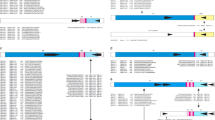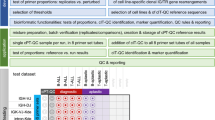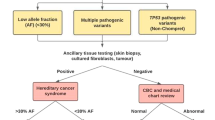Abstract
Patients with Nijmegen Breakage Syndrome (NBS) have a high risk to develop malignant diseases, most frequently B-cell lymphomas. It has been demonstrated that this chromosomal breakage syndrome results from mutations in the NBS1 gene that cause either a loss of full-length protein expression or expression of a variant protein. A large proportion of the known NBS patients are of Slavic origin who carry a major founder mutation 657del5 in exon 6 of the NBS1 gene. The prevalence of this mutation in Slav populations is reported to be high, possibly contributing to higher cancer risk in these populations. Therefore, if mutations in NBS1 are associated with higher risk of developing lymphoid cancers it would be most likely to be observed in these populations. A multiplex assay for four of the most frequent NBS1 mutations was designed and a series of 119 lymphoma patients from Slavic origin as well as 177 healthy controls were tested. One of the patients was a heterozygote carrier of the ACAAA deletion mutation in exon 6 (1/119). No mutation was observed in the control group, despite the reported high frequency (1/177). The power of this study was 30% to detect a relative risk of 2.0.
Similar content being viewed by others
Introduction
Nijmegen Breakage Syndrome (NBS) is an autosomal recessive chromosomal instability disorder similar to the ataxia telangiectasia (AT) resulting in microcephaly, growth retardation, and immunodeficiency. Malignancies of lymphoid origin at young age present with defects in the cell cycle check points and increased sensitivity to ionising radiation.1,2,3 Moderately elevated cancer risk for heterozygote carriers of mutations in the ATM gene has been reported for leukemias, non-Hodgkin's lymphomas and breast cancer.4
The gene (NBS1) of a size of 56 kb is localised on 8q21.3, and codes for a gene product termed Nbs1, p95, or nibrin of 754 amino acids.5 The protein is an essential part of a multifunctional complex involved in DNA double-strand break repair and response to radiation. Interactions of nibrin with BRCA1 and ATM/ATR have been shown upon DNA damage.6 Nibrin forms a complex with Mre11, and Rad50 in vivo,7 which has suggested functions in both homologous recombination and nonhomologous end-joining and also a role in telomere maintenance. Nibrin is itself essential for some catalytic activities of this complex such as ATP-dependent partial unwinding of a DNA duplex8 and the ATM-dependent activation (phosphorylation) of Chk2 upon gamma radiation.9 The abrogation of this activation leads to entry into mitosis immediately after radiation suggesting that checkpoint defects may result from inability to activate Chk2. However, evidence for Nbs1-dependent phosphorylation of CHK2 has been obtained from some cell lines,9 but not in others, where repair defects rather than a check point arrest have been proposed as a mechanism to increased radiosensitivity.10 Nibrin has been shown to be essential in the radiation-induced phosphorylation of Mre11 (human meiotic recombination 11), by recruiting specific kinases.11 Initially, the 657del5 allele was suggested to lead to a premature stop and a truncated protein giving a surprisingly mild phenotype, given that the mouse NBS1 knockout leads to early embryonic lethality.12 Recently, an alternative translation was shown to lead to a variant, possibly partly functional NBS1 protein.13 Using screening techniques designed to detect carriers of the common mutations Varon et al found an unexpectedly high carrier frequency of the 657del5, which may contribute to cancer frequency in the studied Slav populations.14 To verify that we designed a study for the simultaneous screening for the mutations in NBS1 in the following positions: exon 6, 657 delACAAA, 698 delAACA, exon 7, 835delCAGA, 842 insT, and exon 10, 1142 delC.
Materials and methods
Subjects
Blood samples were obtained from 119 patients with Hodgkin's and non-Hodgkin's lymphoma. The recruited patients comprised of white Slavic Caucasians attended the 1st Department of Internal Medicine of the University Hospital in Prague. The following data on patients were retrieved from medical records: age, sex, clinical stage, presence of symptoms, nodal status, tumour size and grade, histopathological classification of tumour, performance status, international prognostic factor, chemotherapy, and result of chemo therapy. A control group was composed of 177 unrelated subjects of Caucasian origin. Controls were recruited mainly from staff of National Institute of Public Health, 3rd Medical Faculty, and inhabitants of houses for elderly citizens living in the same urban area as patients. Controls had no previous medical record of lymphoma or other cancer disease. The composition of control group was com-parable to cases in terms of age and sex (83 females and 94 males, prevalence of subjects older than 50). Patients and controls were asked to read and sign an Informed Consent in agreement with requirements of the Ethical Commission of the National Institute of Public Health in Praha.
DNA extraction
Genomic DNA was isolated from peripheral lympho-cytes by the phenol/chloroform extraction method followed by ethanol precipitation according to standard protocols.
Mutation screening
A single tube, multiplex PCR analysis of the major known mutations in NBS1 was developed using the three primer pairs given in Table 1.
DNA (50–100 ng) were mixed with 30 pmol of each primer, 0.2 mM of each dNTP, 1.2 mM MgCl2, PCR Buffer II from Perkin-Elmer (MgCl2-free), and 0.75 U Taq polymerase (Perkin-Elmer Cetus, Norwalk, CT, USA) in a final volume of 30 μl. After initial denaturation at 93°C for 30 s, amplification was accomplished using a protocol with 20 cycles including 30 s at 94°C, 30 s at 62–42°C with a decrement of 1° in each cycle, and 30 s at 72°C, followed by 10 cycles with annealing temperature 49°C in each cycle, with a final extension of 10 min at 72°C in a PE9600 cycler. The fragment lengths of the PCR products were 136 bp for exon 6, 140 bp for exon 7, and 160 bp for exon 10 of NBS1 (Figure 1). Primers were labelled with FAM for exon 6, HEX for exon 7 and TET for exon 10. After completion of the multiplex PCR reaction with labelled primers, the mix was analysed by a single run of capillary electrophoresis on ABI PRISM™310. Running conditions at voltage 15 kV, 5 s injection time and a length of run of 24 min were set for optimal detection of the polymorphic alleles.
Multiplex PCR reaction was analysed by a single run of capillary electrophoresis on ABI PRISM™310. The fragment lengths of the PCR products, 134 bp for exon 6, 140 bp for exon 7, and 160 bp for exon 10 of NBS1 for the homozygous wt are given relative to the internal standard. Primers were labelled with FAM for exon 6 (two blue peaks for a heterozygous deletion of 5 bp), HEX for exon 7 (two black peaks for a heterozygous deletion of 4 bp) and TET for exon 10 (two green peaks for a heterozygous deletion of 1 bp). Running conditions at voltage 15 kV, 5 s injection time and a length of run of 24 min were set for optimal detection of the polymorphic alleles.
Results
A single tube, multiplex PCR-based method for screening of the major known mutations in NBS1 has been developed (Figure 1). Using this method we screened for mutated NBS1 alleles in 119 lymphoma patients of Czech origin and 177 controls. In addition, the studied exons (exons 6, 7, and 10) have been amplified separately and sequenced to verify the results in 11 randomly chosen patients and 13 controls. One of the patients was a heterozygote carrier of the ACAAA deletion mutation in exon 6 (1/119) (Figure 2). No mutation was observed in the control group, despite the reported high frequency (1/177)14 of the 657del5 mutation in Slavic populations. The present study does not therefore report an increased relative risk for lymphoma patients carrying the Slavic mutation although it was observed in one of the patients (n=119) and in none of the controls (n=177). The probability of finding no mutations, if the true probability in the population is P, can be calculated as follows (using the formula for the binomial distribution):

In our example n=119 and P=0.005 (or 1/177) the probability of observing one mutation would be 0.995119=0.55. If the true probability was twice that observed in the control population (P=2/177) then it is 0.99119=0.30 (P=0.01), that is, our study had a 30% probability to detect an RR=2.
Discussion
Both Hodgkin's and non-Hodgkin's lymphomas constitute a diverse group of malignancies with respect to histology, clinical presentation and disease progression. Genetic polymorphisms in xenobiotic metabolising enzymes of the cytochrome P450 and glutathione S-transferase superfamilies may contribute to disease risk.15 The possible involvement of mutations in the NBS1 gene in the pathogenesis of lymphoid diseases is suggested by the fact that this is the most common form of malignancy suffered by NBS patients.1 Furthermore, mutations in the gene were found in some cases (14.9%) of childhood acute lymphoblastic leukemia15 but not large deletions in the NBS1 area on chromosome 8q.17 Since at least one of the known variants, 657del5 in exon 6, was found in 1/177 healthy individuals of Slav origin,14 we believed that it is feasible to expect a higher frequency of carriers of this mutation in lymphoma patients of the same population. Our results did not confirm this hypothesis in the studied patient groups. A larger set of both cases and controls is under investigation. However, the rapid and convenient screening technique that we introduce in this study could be used for larger population screening or for patient groups with increased radiosensitivity and abnormal response to radiation treatment.
References
Gatei M, Young D, Cerosaletti KM et al: ATM-dependent phosphorylation of nibrin in response to radiation exposure. Nat Genet 2000; 25: 115–119.
Varon R, Vissinga C, Platzer M et al: Nibrin, a novel DNA double-strand break repair protein, is mutated in Nijmegen breakage syndrome. Cell 1998; 93: 467–476.
Seemanova E: An increased risk for malignant neoplasms in heterozygotes for a syndrome of microcephaly, normal intelligence, growth retardation, remarkable facies, immunodeficiency and chromosomal instability. Mutat Res 1990; 238: 321–324.
Olsen JH, Hahnemann JM, Borresen-Dale AL et al: Cancer in patients with ataxia-telangiectasia and in their relatives in the nordic countries. J Natl Cancer Inst 2001; 93: 84–85.
Matsuura S, Tauchi H, Nakamura A et al: Positional cloning of the gene for Nijmegen breakage syndrome. Nat Genet 1998; 19: 179–181.
Zhong Q, Chen CF, Li S, Chen Y, Wang CC, Xiao J, Chen PL, Sharp ZD, Lee WH: Association of BRCA1 with the hRad50–hMre11–p95 complex and the DNA damage response. Science 1999; 285: 747–750.
Carney JP, Maser RS, Olivares H et al: The hMre11/hRad50 protein complex and Nijmegen breakage syndrome: linkage of double-strand break repair to the cellular DNA damage response. Cell 1998; 93: 477–486.
Paull TT, Gellert M: Nbs1 potentiates ATP-driven DNA unwinding and endonuclease cleavage by the Mre11/Rad50 complex. Genes Dev 1999; 13: 1276–1288.
Buscemi G, Savio C, Zannini L et al: Chk2 activation dependence on Nbs1 after DNA damage. Mol Cell Biol 2001; 21: 5214–5222.
Girard PM, Foray N, Stumm M et al: Radiosensitivity in Nijmegen Breakage Syndrome cells is attributable to a repair defect and not cell cycle checkpoint defects. Cancer Res 2000; 60: 4881–4888.
Dong Z, Zhong Q, Chen PL: The Nijmegen breakage syndrome protein is essential for Mre11 phosphorylation upon DNA damage. J Biol Chem 1999; 274: 19513–19516.
Zhu J, Petersen S, Tessarollo L, Nussenzweig A: Targeted disruption of the Nijmegen breakage syndrome gene NBS1 leads to early embryonic lethality in mice. Curr Biol 2001; 11: 105–109.
Maser RS, Zinkel R, Petrini JHJ: An alternative mode of translation permits production of a variant NBS1 protein from the common Nijmegen breakage syndrome allele. Nat Genet 2001; 27: 417–421.
Varon R, Seemanova E, Chrzanowska K et al: Clinical ascertainment of Nijmegen breakage syndrome (NBS) and prevalence of the major mutation, 657del5, in three Slav populations. Eur J Hum Genet 2000; 11: 900–902.
Sarmanova J, Benesova K, Gut I, Nedelcheva-Kristensen V, Tynkova L, Soucek P: Genetic polymorphisms of biotrans-formation enzymes in patients with Hodgkin's and non-Hodgkin's lymphomas. Hum Mol Genet 2001; 10: 1265–1273.
Varon R, Reis A, Henze G, Einsiedel HG, Sperling K, Seeger K: Mutations in the Nijmegen breakage syndrome gene (NBS1) in childhood acute lymphoblastic leukemia (ALL). Cancer Res 2001; 61: 3570–3572.
Stanulla M, Stumm M, Dieckvoss BO et al: No wevidence for a major role of heterozygous deletion of 657del5 within the NBS1 gene in the pathogenesis of non-Hodgkin's lym-qphoma of childhood and adolescence. Br J Haematol 2000; 109: 117–120.
Acknowledgements
This work was supported with research grant 122772/310 by the Norwegian Cancer Society, exchange grant from the International Department of University in Oslo for guest researcher Pavel Soucek, as well as grant IGA 6747-3 of the Internal Grant Agency of Czech Ministry of Health.
Author information
Authors and Affiliations
Corresponding author
Rights and permissions
About this article
Cite this article
Soucek, P., Gut, I., Trneny, M. et al. Multiplex single-tube screening for mutations in the Nijmegen Breakage Syndrome (NBS1) gene in Hodgkin's and non-Hodgkin's lymphoma patients of Slavic origin. Eur J Hum Genet 11, 416–419 (2003). https://doi.org/10.1038/sj.ejhg.5200972
Received:
Revised:
Accepted:
Published:
Issue Date:
DOI: https://doi.org/10.1038/sj.ejhg.5200972
Keywords
This article is cited by
-
Genetic variation in the NBS1, MRE11, RAD50 and BLM genes and susceptibility to non-Hodgkin lymphoma
BMC Medical Genetics (2009)
-
Role of single nucleotide polymorphisms and haplotypes in BRCA1 in breast cancer: Czech case–control study
Breast Cancer Research and Treatment (2007)
-
The genetics of familial lymphomas
Current Oncology Reports (2004)





